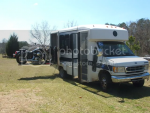I need to get a new ramp for my truck. I'm currently using the Haul-Master tri-fold ramps (two narrow ones) from Harbor Freight, but they are dangerous to use by myself. I always need help from someone (and backed up to a hill) when I try to load it. I'd like to find a wider one to be able to ride up and have both feet on the ramp for stability. I'd also like to buy one for my son to be able to take his motorcycle (he rides a sportbike) to college with his truck and safely be able to load and unload it himself.
I was thinking of buying another set from Harbor Freight and bolting three together. Since I'll be making one for me and one for my son, if I buy two sets from HF, with three sets, I'll be able to make two working wide ramps. But, if any of you have a better idea that won't be too expensive, I'd love to hear your ideas.
Thanks!
This is what I have now: 1000 lb. Capacity 9 in. x 72 in. Tri-Fold Loading Ramps, Set of Two
This is one I'm considering, too: 1500 lb. Capacity 45 in. x 69 in. Tri-Fold Aluminum Loading Ramp
I was thinking of buying another set from Harbor Freight and bolting three together. Since I'll be making one for me and one for my son, if I buy two sets from HF, with three sets, I'll be able to make two working wide ramps. But, if any of you have a better idea that won't be too expensive, I'd love to hear your ideas.
Thanks!
This is what I have now: 1000 lb. Capacity 9 in. x 72 in. Tri-Fold Loading Ramps, Set of Two
This is one I'm considering, too: 1500 lb. Capacity 45 in. x 69 in. Tri-Fold Aluminum Loading Ramp







